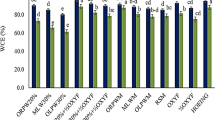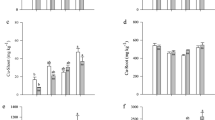Abstract
The threat of spreading diseases is a serious concern when organic wastes are applied to farmland. Irradiation and composting are effective methods to reduce pathogens. Field experiments were conducted to assess the influence of these pathogen-eliminating methods on plant availability of Zn in the wastes. Four organic wastes: digested and dewatered (DSS), irradiated (DISS), composted (DICSS) sewage sludge and composted livestock manure (CLM) were applied during two growing seasons at 10, 20, 30, and 40 t solids ha−1 year−1. Available N and K in the wastes were estimated and N and K fertilizers were added to the soil to equalize available N and K supply among treatments to avoid dilution of crop Zn concentration. A control treatment (CT) received fertilizers but no waste. Lettuce, snap beans and petunias were grown in 1990, and two cuts of lettuce were harvested in 1991. The influence of waste Zn application on crop Zn concentration was studied within approximately equal crop yields. Crop Zn concentration increased in all crops treated with DSS or DISS, and often reached a maximum at the 30 t ha−1 rate of application, then slightly decreased at 40 t ha−1. The response of crop Zn concentration to the amount of Zn applied in the wastes was best described by quadratic equations. Waste application also significantly increased soil Zn availability index, which was a function of DTPA (diethylenetriamine pentaacetic acid)-extractable soil Zn and soil pH. The index was highly correlated with crop Zn concentration. Although Zn concentration in DICSS was similar to those in DSS and DISS, Zn applied in DICSS did not increase crop Zn concentration or soil availability index. Composting reduced the availability of Zn. The similar concentrations of Zn in DSS and DISS in both years allowed the use of a paired t-test to determine the differences in crop Zn concentration caused by application of DSS and DISS. Zinc applied in DISS produced a higher Zn concentration in bean pods than Zn applied in DSS (t > T 0.05 at P < 0.02, df = 15), indicating that irradiation increased phytoavailability of Zn in the sludge. However, no similar effect was found in Zn concentrations in the two cuts of lettuce in 1991 or in soil Zn availability index.
Similar content being viewed by others
References
Barbarick K A, Ippolito J A and Westfall D G 1995 Biosolids effect on phosphorous, copper, zinc, nickel, and molybdenum concentration in dryland wheat. J. Environ. Qual. 24, 608-611.
Bates T E, Haq A, Soon Y K and Moyer J R 1975 Uptake of metals from sewage sludge amended soils. In Proceedings of International Conference on Heavy Metals in the Environment. Toronto, Ontario, Canada 27-31 October. pp. 403-416.
Bell P F, James B R and Chaney R L 1991 Heavy metal extractability in long-term sewage sludge and mental salt-amended soil. J. Environ. Qual. 20, 481-486.
Benckiser G and Simarmata T 1994 Environmental impact of fertilizing soils by using sewage and animal wastes. Fertil. Res. 37, 1-22.
Bremner J M and Mulvaney C S 1982 Nitrogen-total: Regular Kjeldehl method. In Methods of Soil Analysis, Part 2 Chemical and Microbiological Properties. 2nd ed. Eds. A L Page, R H Miller and D R Keeney. Am. Soc. Agron., Madison, WI. pp. 610-616.
Cabrera F, Díaz E and Madrid L 1989 Effect of using urban compost as manure on soil contents of some nutrients and heavy metals. J. Sci. Food Agric. 47, 159-169.
Campanella L, Ferri T, Petronio B M and Piccolo A 1989 Effect of speciation in sludges on the adsorption of leached metals from soil. Sci. Total Environ. 79, 223-231.
CEM Corporation 1990 CEM Application Note EW-5. Microwave digest of municipal waste, compost etc. CEM Corporation, P.O. Box 200, Mattews, NC, 28106, USA.
Chang C, Sommerfeldt T G and Entz T 1991 Soil Chemistry after eleven annual applications of cattle feedlot manure. J. Environ. Qual. 20, 475-480.
Deiana E, Gessa C, Manunza B, Rausa R and Seeber R 1990 Analytical and spectroscopic characterization of humic acid extracted from sewage sludge, manure, and worm compost. Soil Sci. 150, 419-424.
Dowdy R H, Larson W E, Titrud J M and Latterrell J J 1978 Growth and metal uptake of snap beans grown on sewage sludgeamended soil: a four-year field study. J. Environ. Qual. 7, 252-257.
Fresquez P R, Francis R E and Dennis G L 1990 Sewage sludge effects on soil and plant quality in a degraded, semiarid grassland. J. Environ. Qual. 19, 324-329.
Garcia W J, Blessin G, Inglett G and Carlson R 1974 Physicalchemical characteristics and heavy metal content of corn grown on sludge-treated strip-mine soil. J. Agric. Food Chem. 22, 810-815.
García C, Hernadez T, Costa F and Polo A 1991 Humic substance in composted sewage sludge. Waste Manage. Res. 9, 189-194.
Gray K R and Biddlestone A J 1980 Agricultural use of composted town refuse. In Inorganic pollution and agriculture. Proc. A conference organized by the Agricultural Development and Advisory Service. pp. 279-305. Ministry of Agriculture, Fisheries and Food, London.
Haq A U and Miller M H 1972 Prediction of available soil Zn, Cu, and Mn using chemical extractants. Agron. J. 64, 779-782.
Hue N V 1988 Residual effects of sewage-sludge application on plant and soil-profile chemical composition. Commun. Soil Sci. Plant Anal. 19, 1633-1643.
Isaac R A and Kerber J D 1971 Atomic absorption and flame photometry: Techniques and uses in soil, plant and water analysis. In: Instrumental Methods for Analysis of Soil and Plant Tissue. Ed. L Walsh. pp. 12-37. Soil Sci. Soc. Am., Madison, WI.
Keeney D R and Nelson D M 1982 Nitrogen-Inorganic Forms. In Methods of Soil Analysis, Part 2, Chemical and Microbiological Properties, 2nd ed. Eds. A L Page, R H Miller and D R Keeney. pp. 643-693. Am. Soc. Agron., Madison, WI.
Kelling K A, Keeney D R, Walsh L M. and Ryan J A 1977 A field study of the agricultural use of sewage sludge: III. Effect on uptake and extractability of sludge-borne metals. J. Environ. Qual. 6, 352-358.
Kirkham M B 1980 Availability of metals in irradiated sewage sludge. J. Agric. Food Chem. 28, 663-665.
Lanyon L E and Heald W R 1982 Magnesium, calcium, strontium, and barium. In Methods of Soil Analysis, Part 2, Chemical and Microbiological Properties. 2nd ed. Eds. A L Page, R H Miller and D R Keeney. pp. 247-271. Am. Soc. Agron., Madison, WI.
Lee C C, Soon Y K and Bates T E 1981 Phosphate adsorption by soil amended with chemically treated sewage sludges. Can. J. Soil Sci. 61, 165-168.
Lindsay W L and Norvell W A 1978 Development of a DTPA soil test for zinc, iron, manganese and copper. Soil Sci. Soc. Am. J. 42, 421-428.
Luo Y M and Christie P 1998 Bioavailability of Copper and Zinc in soils treated with alkaline stabilized sewage sludges. J. Environ. Qual. 27, 335-342.
McCalla T M 1974 Use of animal wastes as a soil amendment. J. Soil Water Conserv. 29, 213-216.
McKeague J A 1979 Manual of Soil Sampling and Methods of Analysis, 2nd ed. Canadian Soil Survey Committee on Methods of analysis. Soil Research Institute, Ottawa, Ontario.
Miller R W, Azzari A S and Gardiner D T 1995 Heavy metals in crops as affected by soil types and sewage sludge rates. Commun. Soil Sci. Plant Anal. 26, 703-711.
Mulvaney R L and Bremner J M 1981 Control of urea transformations in soils. In Soil Biochemistry. Eds E A Paul and J N Ladd, Vol. 5, pp. 153-196. Marcel Dekker, New York.
NMSU Agricultural experiment station 1982 Potential fertilizer value of gamma irradiated sewage sludge on calcareous soils. New Mexico State Univ., Agriculture Experiment Station Bull. 692.
OMAF Ontario Ministry of Agriculture and Food 1990 1991-1992 Field crop recommendations. pp. 6. Publication 296. OMAF Canada
Olsen S R and Sommers L E 1982 Phosphorus: Phosphorus soluble in sodium bicarbonate. In Methods of Soil Analysis, Part 2, Chemical and Microbiological Properties. 2nd ed. Eds A L Page, R H Miller and D R Keeney. pp. 421-422. Am. Soc. Agron., Madison, WI.
Pierzynski G M and Schwab A P 1993 Bioavailability of zinc, cadmium, and lead in a metal-contaminated alluvial soil. J. Environ. Qual. 22, 247-254.
Rosopulo A, Fieldler I, Staerk H and Suess A 1975 Experience with a pilot plant for the irradiation of sewage sludge: analytical studies on sewage sludge and plant material. International Atomic Energy Agency Symposium. Munich.
Rynk R, M. van de Kamp G B, Willson M E, Singley T L, Richard J J, Kolega F R, Gouin L, Laliberty Jr, Kay D, Murphy D W, Hoitink H A J and Brinton W F 1992 On farm composting. Northeast. Reg. Agric. Eng. Serv., Ithaca, NY.
SAS Institute 1989 SAS User's guide. Version 6.08. SAS Institute, Cary, NC.
Sims J T and Kline J S 1991 Chemical fractionation and plant uptake of heavy metals in soils amended with co-composted sewage sludge. J. Environ. Qual. 20, 387-395.
Soon Y K, Bates T E and Moyer L R 1980 Land application of chemically treated sewage sludge: III. Effects on soil and plant heavy metal content. J. Environ. Qual. 9, 497-504.
Stevenson F J 1982 Origin and distribution of nitrogen in soil. In Nitrogen in Agricultural Soils. Ed F J Stevenson. pp 1-39. Agron. Monogr. ASA, CSSA, and SSSA, Madison, WI.
Thomas R L, Sheard R W and Moyer J R 1967 Comparison of conventional and automated procedures for N, P, and K analysis of plant material using a single digestion. Agron. J. 59, 240-243.
US EPA 1993 Environmental regulations and technology: Use and disposal of municipal wastewater sludge. US Environmental Protection Agency 503.48, U.S. Government Printing Office, Washington, DC.
van der Watt H v H, Summer M E and Cabrera M L 1994 Bioavailability of copper, manganese, and zinc in poultry litter. J. Environ. Qual. 23, 43-49.
Villar M C, Beloso M C, Acea M J, Cabaneiro A, González-Prieto S J, Carballas M, Díaz-Raviña M and Carballas T 1993 Physical and chemical characterization of four composted urban refuses. Bioresour. Technol. 45, 105-113.
Watanabe M and Kurihara K 1982 Physicochemical characteristics of municipal refuse compost for agricultural use. The Bulletin of the National Institute for Agriculture Science, Series B, No. 33, 95-164. USA.
Webber M D 1984 Land utilization of sewage sludge-a discussion paper. Prepared jointly by Environment and Agriculture Canada at the request of the Expert Committee on Soil and Water Management of the Canada Committee on Land and Water Management, Research Branch, Agriculture Canada, Ottawa.
Wen G, Bates T E and Voroney R P 1995 Evaluation of nitrogen availability in irradiated sewage sludge, sludge compost and manure compost. J. Environ. Qual. 24, 527-534.
Wen G, Winter J P, Voroney R P and Bates T E 1997 Potassium availability with application of sewage sludge, and sludge and manure composts in field experiments. Nutr. Cycl. Agroecosyst. 47, 233-241.
Wong M H, Mok C M and Chu L M 1983 Comparison of refuse compost and activated sludge for growing vegetables. Agric. Wastes pp. 65-75.
Author information
Authors and Affiliations
Corresponding author
Rights and permissions
About this article
Cite this article
Wen, G., Bates, T.E., Voroney, R.P. et al. A yield control approach to assess phytoavailability of Zn and Cu in irradiated, composted sewage sludges and composted manure in field experiments: I. Zinc. Plant and Soil 246, 231–240 (2002). https://doi.org/10.1023/A:1020661225434
Issue Date:
DOI: https://doi.org/10.1023/A:1020661225434




